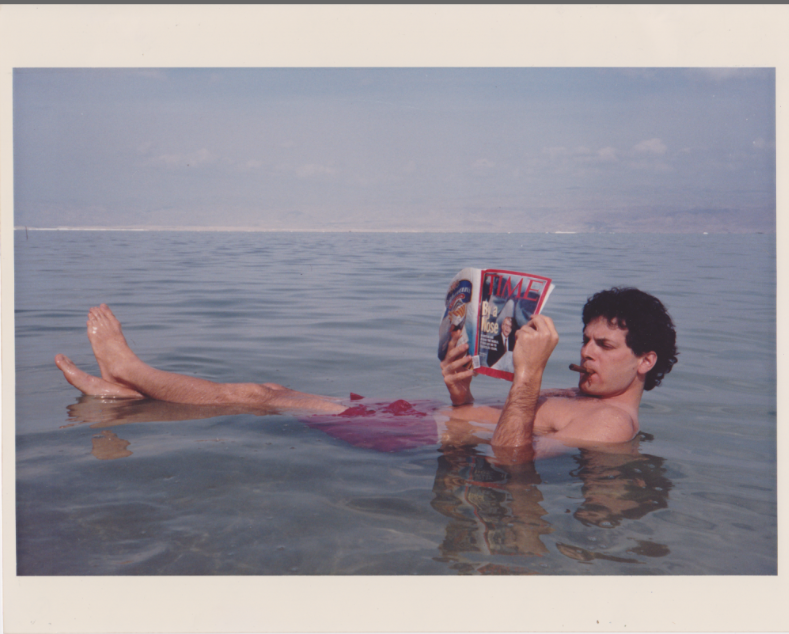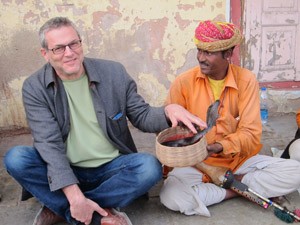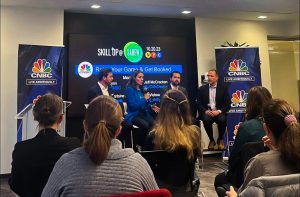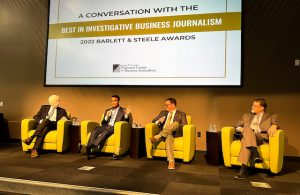Throughout his career, Richard Behar has traveled to more than 40 countries and written award-winning investigative pieces for Forbes, Time and Fortune magazines and a wide-range of other publications.
In 2008, SABEW awarded him the “Best in Business Award” for an enterprise piece he wrote in the sub-Sahara for Fast Company magazine called “China Storms Africa.” His other award-winning pieces include topics such as terror financing in Karachi, counterfeiting in Beijing and corporate wrongdoing on Wall Street. In 2005, he launched Project Klebnikov to investigate the murder of Paul Klebnikov, the editor-in-chief of the Russian edition of Forbes magazine, and to further the investigative work Klebnikov began .
Investigative reporting isn’t Behar’s only strong suit. He has also written many feature and profile stories, including one on Donald W. Reynolds that appeared in Forbes magazine in 1986.
Behar returned to Forbes in 2012 as Contributing Editor of Investigations, after freelancing for seven years, and is in the process of writing a book about Bernie Madoff. He was also recently named a finalist in the 2013 Gerald Loeb awards for his Forbes piece, “Hess Oil’s Russian Mob Problem.“
In the interview below, Behar opens up about international investigative business reporting, offers tips on how to profile an executive and sheds light on the current state of investigative journalism.
How have your international travels enhanced your business reporting?
It’s inconceivable to me that a business reporter could be any good without global travel. It would be like an archaeologist not visiting Rome or Athens, and yet feeling in a position to opine about ancient rocks. Reading about overseas business is not the same as seeing it in action, and you do your readers a disservice without having that expanded context. For example, my writing about the underground economy of Pakistan after 9-11 would have made it virtually impossible (certainly uninteresting) without watching it in action on the streets of Karachi and other major cities there.
Unfortunately, journalism organizations have cut back ferociously on their foreign bureaus and foreign travel, and so American readers are worse off for it. They know less about what’s really happening around the world in business communities as a result. Hopefully, someday that will reverse when online journalism models get their acts together and start making sense.
What is the most satisfying part of writing an investigative business story? What are the biggest hurdles?
For me, the most exhilarating part of the writing process is when your monstrous and frightening mountain of notes and interviews (the “clay”) begins to pop off the page in a way that your central theme becomes crystal clear. As journalism students are taught (correctly), every story must have only one central theme, but can be supported by several sub-themes. And once the central theme becomes clear, if you’re lucky, the sub-themes start connecting themselves–almost magically. It’s like a process of triangulation that takes place. By the way, creating lengthy chronologies can get a reporter there faster. In common parlance, it’s really just dot-connecting, it’s thread-tying. And it’s like watching heaven appear on your computer screen.
The biggest hurdles? When you stare at the computer for days and this wonderful process never happens!
What are the dangers of investigative reporting and what advice do you have for journalists pursuing “scary” stories?

The more people who know what you are doing, the safer you will be. (Sunshine is a criminal’s worst enemy.) I wouldn’t advise any reporter to pursue a physically-dangerous story alone. Once again, there is more safety in numbers. Make sure your editor knows where you are at all times, even if it’s just out for a lunch with potential sources. (And let your editor know who those sources are.) Share your findings with your editor at every step of the way, and make sure the bad guys know this fact as well — if you are ever placed in a dire situation by them.
Several years ago, I proposed an idea to a major journalism organization, but it seems there was a lack of interest. While the details would have had to be ironed out, I thought an investigative group should be created — really an investigative cyber-vault — where reporters could keep copies of their work product at each stage of their project. It would obviously have to be guarded like a Fort Knox, especially given the competitive nature of reporting. In return, that reporter would be publicly identified as a member of this group, so that anybody considering killing her or him would know in advance that such an act would not kill the work.
Think about it. The primary reason somebody would kill a reporter is to stop what that reporter was planning to expose — not as payback for an earlier piece. (Simple vengeance is too risky for a killer.) Bob Greene used to say that if reporters banded together after the killing of a journalist, for the purpose of continuing that reporter’s story — as he did while leading the famed Arizona Project — it becomes a kind of ‘life insurance’ policy for all investigative journalists. The message to a potential killer, as Bob put it, is: “If you kill a reporter, the work will multiply.” Sadly, in today’s era, if you kill a reporter, the work usually dies, too. I think such a “vault” is doable, and in fact we owe it to our colleagues to at least try it — given how many reporters are contract-killed each year.
First off, I tell journalism students that if you’re doing a profile of President Obama, then 20 minutes on the phone suffices. Nice scoop! But if you’re writing a profile about the CEO of a company (and I mean no disrespect to their importance), then 20 minutes doesn’t cut it. An hour doesn’t cut it. Half a day doesn’t cut it — not if you want to create something exceptional and unique and truly memorable for a reader. And if the interview takes place in that executive’s office, you might as well just turn off the recorder and go home — because your profile probably won’t be any good at all.
When an executive I’m profiling asks me how much time I’ll need to spend with him/her, my usual response is, “I’m greedy. I need as much time as you will tolerate. Let me come to your home, meet your family, sit quietly and watch you work and speak with employees.” I tell them that portions of it can be off-the-record (requiring their clearance afterwards for publishing), but that the more time I spend with them in various contexts, the more that I (as a proxy for the reader) can paint a better and more accurate portrait of them. If they are too busy, I ask if I can just ride with them in a taxi to the airport, or wait with them in a lounge there. I ask if I can pick them up when their plane lands. Have a beer with them in a bar, or toss a ball with their kids. You get the idea.
In the case of Don Reynolds, and my profile of him was one of the most enjoyable I’ve ever done, I managed to get him to invite me for an entire weekend in his mansion in Las Vegas. Some of our best conversations were in his gargantuan jacuzzi– which was literally bigger than my 5th-floor walk-up apartment in New York. We liked each other; we really enjoyed each others’ company, even though I have to admit that I despised his brand of cheapskate journalism. One thing that concerned me was that he revealed deep and negative feelings about his children (on-the-record) that I thought he might regret once the piece was published. To the contrary, he phoned me up and asked how he could purchase 50 or 100 copies of the magazine. He was such a hoot — one of the greatest characters and barons of the 20th-century media world.
What advice do you have for reporters interested in investigative financial journalism?
Advice? In 2013? You mean other than find something else to do with your life? Perhaps plumbing? Or becoming a ballerina? Or raising some pigs on a farm? I truly don’t have any advice that’s worth much, given how the industry is going through so much change and turmoil–an industry in which everyone’s blogging grandmother thinks they’re a journalist. The old avenues to success are largely dead, dying, or morphing into something that is still hazy. Most of the great investigative business reporters (and editors) I know have either quit, been laid off, or are hanging on by their fingernails to their jobs. Getting their attention is about as easy as that old saw from Woody Allen about show business: “It’s worse than dog-eat-dog. It’s dog-doesn’t-return-other-dog’s-phone-calls, which reminds me. I should check my answering service.”
One problem is that the best investigative financial reporting is going to be lengthy–it’s going to delve into the systemic problems of an agency or business, for example–and print publications can’t spare the space like they used to. As for the web, we are told that readers don’t have the attention span to get beyond a few thousand words. The last gigantic piece I did was a 24-pager for Fast Company about what China is doing in Africa. While it won prestigious awards, how many people actually read it? One of my mentors, Newsday’s Bob Greene, assembled the country’s first full-time investigative team at a national newspaper, only to live long enough to watch the Pulitzer-winning unit ripped to shreds by the paper’s accountants. In his final years, he would rant and rave–few listened–about how today’s cutbacks in long-form, high-quality probes were harming our democracy. As he once told me, our founding fathers didn’t give us the First Amendment “to publish apple pie recipes.”
Look, the only hope for young reporters interested in investigative financial journalism is to band together and become entrepreneurs and figure out how to create a model that works, with exposes that readers want, and that produces enough profit to sustain itself. And if they can’t, then the public has decided, sadly enough, that they are not interested in having it.
Sorry to be so bleak. But those younger reporters who, in their blood and guts, have the drive to be investigative financial reporters are gonna find the route.











